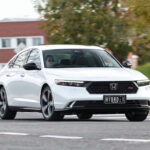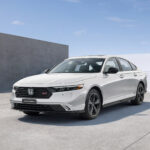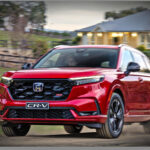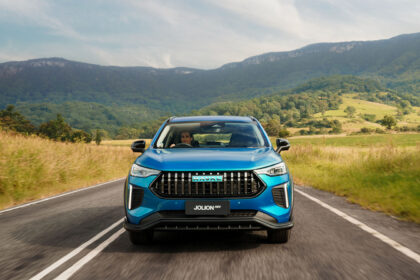Honda cars have long held a reputation as being a step above other Japanese marques in quality and prestige. Nowhere does this show more than in the medium-large Accord sedans.
These days the Honda Accord sells in Australia in two different market segments. One, called Accord Euro, has a real emphasis on sporty handling and has gained a good reputation amongst those who enjoy driving. It gives, precise communicative steering and plenty of road grip. Handling was improved further when an upgraded Euro model arrived in Australia in June 2008.
The other variant, simply called the Honda Accord, is larger, American-based and leans in the direction of passenger comfort rather than sporty dynamics.
Many owners only drive gently and find the Accord’s characteristics most acceptable. Those drivers with more of a sporting makeup will find these Accords are rather soft and inclined to understeer at relatively slow speeds.
Australia is the only country that takes imports of the two significantly different models, showing the high regard in which our country is held by the head office chiefs in Japan.
Honda Accords in Australia are four-door sedans (though the European market also has a station wagon variant). Interior space is good, though the Euro is smaller than American Accord so for adults to get comfortable in the rear seat the front seats have to be set a few notches forward.
Boot space is good, with a wide, low opening which makes it easy to load. Naturally, the boot in the larger car has greater volume, but the Euro’s luggage area is more than acceptable if only couples are using the car.
The Honda tradition of designing cars with good outward visibility makes the Accord easy to drive and park, as well as making it comfortable for young children to see out of. However, crash safety regulations that made thick pillars necessary mean that there’s less outwards visibility in the these post-2003 Accord. They aren’t bad, just not as good as the excellent older models.
A four-cylinder engine used in the Euro model and the American Accord has a capacity of 2.4 litres. The engine in the Euro is set to a higher state of tune than the one in the American car so need high octane unleaded petrol, the Accord is happy to run on 91, though a diet of 95 does seem to make it feel good.
A V6 3.0-litre unit is used in the American Accord, but not in the Euro. The 2008 model change saw an increase in the V6 engine size to 3.5 litres. The newer engine design offers plenty of relaxed torque and uses less fuel than the smaller engine it replaced.
The Accord Euro is offered with a six-speed manual to suit its sporting nature, though in Australia most are fitted with a five-speed sequential automatic. The American car is imported only with a five-speed automatic transmission.
The Honda dealer network usually concentrates on the major population centres. If you live in the relatively remote country area it might be wise to make inquiries to Honda’s head office, or your local regional office, if you are considering buying one of the cars. Ask about the time it takes to source parts, although this is unlikely to be more than a couple of business days.
Honda has worked hard at reducing spare parts costs in recent years. However, the price drops usually apply more to the common parts than to the unusual ones.
These are relatively complex cars, especially from the 1998 model, and are best left to professional mechanics. A good amateur, armed with a workshop manual, can tackle some of the routine work.
Insurance is generally very reasonable as is only to be expected from a car in this ultra conservative market segment. It will be interesting to see if the new sport-oriented Accord Euro changes the premium structure.
WHAT TO LOOK FOR
The engine should be all but inaudible at idle, even in the four-cylinder units. Any roughness may indicate problems.
Check there are no oily black stains in the exhaust pipe and the surrounding body and bumper. Make sure there isn’t a puff of oily looking smoke from the exhaust when the accelerator is floored after the engine has been idling for a minute or so.
Manual gearboxes should move freely with no sticking or crunching on fast gearchanges. Automatics should go into gear promptly and their changes should only be noticeable when you’re accelerating hard.
During your test drive check the brakes pull the car up evenly without one wheel locking before the others. On cars with ABS, feel for a pulsing through the pedal during very hard braking.
Look at the condition of the interior, paying special attention to the top of the dashboard and the rear shelf for sun damage. Fading or cracking in these areas can cause hassles.
Rust is not common but may have found its way into cars that have been badly repaired after a crash. If you’re not sure, have a professional check out the car as repairs can be expensive.
HOW MUCH?
Expect to pay from $4000 to $7000 for 2003 Honda Accord VTi; $6000 to $10,000 for a 2004 Accord Euro; $10,000 to $16,000 for a 2006 Accord V6; $14,000 to $20,000 for a 2008 Accord Euro Tourer; $19,000 to $26,000 for a 2010 Accord VTi Luxury; $26,000 to $35,000 for a 2011 Accord V6-L; and $29,000 to $40,000 for a 2012 Accord Uro Luxury Navi.
CAR BUYING TIP
Cars used by families often have more wear and tear in the boot than those used by couples. The condition of the back seat in a kid carter depends greatly on the amount of discipline the juniors have been taught…














